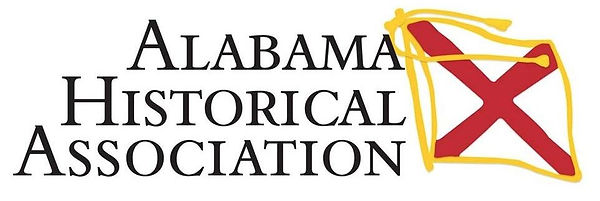
Former Site of Battelle
Thriving iron ore and coal mining community of early 1900's
Established by Colonel John Gordon Battelle
Five miles north of Valley Head
[1973: County Road 137 @ Winston Street in Valley Head
34.57042 N 85.61559 W ]
Fort Payne's Fort
The fort, consisting of a log house and large stockade, was built in 1838 by order of General Winfield Scott, commander of military forces responsible for the removal of Cherokee Indians.
Soldiers occupying the fort were commanded by Captain John C. Payne, for whom the fort was named.
Indians in the DeKalb County area who refused to move westwards voluntarily were gathered and held in the stockade pending their forceful removal to the Indian territory.
Chimney still standing on site of fort near the railroad at 4th Street S.E.
[1983: U.S. Hwy 11 (Gault Ave.) @ AL Hwy 35 in City Park 34.44357 N 85.72001 W]
Fort Payne Opera House
Opened September1890. Built during local boom period. Converted into theatre during era of silent movies. Closed as a theatre in October 1935. Purchased by Landmarks of DeKalb County, Inc., 1969. Renovated, restored, and reopened to public in 1970. The oldest theatre in Alabama located in a building originally constructed as a theatre. Listed in the National Register of Historic Places and the National Register of 19th Century Theatres in America.
[1973: 520 U.S. Hwy 11 (Gault Ave.) @ 5th Street NW
34.44470 N 85.71935 W]
Indian Mound, Inn, and Church Site
Cherokee Indians first inhabited this mound site, subsequently settled by A.H. Lamar, a captian in the Seminole War and first constable (1836) of DeKalb County. Lamar and his Cherokee wife operated trading post and stage coach stop on site, selling the property to Alfred Collins, ca. 1842. Collins, for whom Collinsville was named, built home and operated inn on the stage coach line here between Rome and Guntersville. Daughter Sallie and her husband, G.W. Roberts, became owners in 1886. Collinsville Baptist Church purchased property in 1924, erecting building on site two years later.
[1996: AL Hwy 68 @ US Hwy 11 in Collinsville
34.26518 N 85.86282 W]
Lebanon Courthouse
Lebanon Courthouse was constructed during the 1840s when Lebanon, the county seat of DeKalb County was a thriving community with inns, taverns, and government offices. This building, built for courthouse use, remained in use as a courthouse until 1876, when the stagecoaches serving Lebanon gave way to progress. The county seat was then moved to Fort Payne, were railway service was available.
This marker was erected as a part of DeKalb 150 Sesquicentennial Celebration, 1836-1986.
[1987: County Road 52 between Ft. Payne and Collinsville. 34.36612 N 85.81625 W]
The Road to Chickamauga
On Aug. 29, 1863, the Union XX Army Corps under Maj. Gen. Alexander M. McCook and the Army of the Cumberland’s cavalry under Maj. Gen. David S. Stanley broke camp at Stevenson, AL and crossed the Tennessee River at Caperton’s Ferry. This force of 20,000 troops was one of three columns dispatched by Union Maj. Gen. William S. Rosecrans to compel a Confederate retreat from Chattanooga, TN, the transportation hub of this region.
McCook’s men ascended Sand Mountain and marched east on Caperton’s Ferry Road, past Chestnut Grove Baptist Church (est. Sept. 1861) to camp sites along Town Creek. On September 4th this column reached the plantation of Winston O. Winston at Valley Head. Four days later, McCook sent his men over Lookout Mountain at Winston’s Gap into Broomtown Valley. From that point his column could intercept Gen. Braxton Bragg’s Confederate Army of Tennessee as it withdrew from Chattanooga.
The armies led by Rosecrans and Bragg eventually clashed on Chickamauga Creek, about thirty miles east of this site. The Union cause suffered its most significant defeat in the Western Theater of the Civil War in the Battle of Chickamauga, Sept. 19-20, 1863.
[2011: Chestnut Grove Baptist Church, Hwy 117]
Sequoyah
(1760-1843) Born in Tennessee, Sequoyah moved to Wills Town (DeKalb County, Alabama) area of the Cherokee Nation in 1818.
Here, in 1821, he invented an 86 symbol alphabet providing the Cherokees with the only written Indian language in the United States.
[1983: U.S. Hwy 11 (Gault Ave.) @ AL Hwy 35 in City Park
34.44369 N 85.71989 W]
Sequoyah
1760-1843. Nearby lived the inventor of written language of Cherokees. Nation adopted it, became only literate Indians with written language. (Sequoyah, maker Cherokee Alphabet)
[Before 1965: U.S. Hwy 11 north of Portersville; missing in 2010]
Wills Town Mission
The mission was established in 1823 by the American Board of Missions to further education and Christianity among the Cherokee Indians. Mission operated until the Indian removal in 1838.
Grave site of Reverend Ard Hoyt, first superintendent, marks the location of the mission near the corner of 38th Street and Godrey Avenue.
[1983: U.S. Hwy 11 (Gault Ave.) @ AL Hwy 35 in City Park
34.44357 N 85.72001 W]